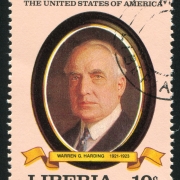Blogging to Offer a New Look
The 2023 Harris’ Farmer’s Almanac offers “A New Look at Warren G Harding”, who, for decades, had been labeled by many historians as our worst president. During his 882 days in office, Harding had indeed made some bad choices. Several of his cabinet appointees took bribes; his extra-marital affairs were well-known. Reporters called him lazy and doubted his intelligence. However, now that presidential records from the early 1900s have been digitalized and available, author Veda Boyd Jones explains, “a more balanced view of President Warren G. Harding has emerged.”
Some of Harding’s notable accomplishments as president include:
- creating the Veterans Bureau
- creating the Bureau of the Budget
- reducing the national deficit
- appointing four Supreme Court justices, including William Howard Taft
- putting in an 84-hour work week, including working lunches
- being the first to visit Alaska , correctly predicting it would become a state
“No matter what size of business you have, you may be presented with a situation where you have to answer some undesired questions or clear up some misconceptions,” the Digital Echidna blog explains. ” While the Web can be your greatest enemy, it can also be your greatest ally. It affords you the opportunity to get your message out, immediately, without the need for a third-party distribution…. explain, apologize, and then lay out exactly what is being done to rectify the situation and ensure it doesn’t happen again.”
Blogs are an ideal vehicle for damage control, we teach at Say It For You. By putting your own “spin” on reports about your company or practice, we teach at Say It For You, you can exercise control over the way the public perceives any negative developments concerning your business or practice. Of course, if you don’t blog frequently, you won’t attract negative comments, but neither will you attract the attention of search engines who deliver readers to your blog site.
Just as the authors of the 2023 Harris’ Farmer’s Almanac used updated information to counteract negative perceptions of former president warren G. Harding, your blog can offer a new look at a situation within your company or practice. Blog to offer readers a new look!






Follow us online!